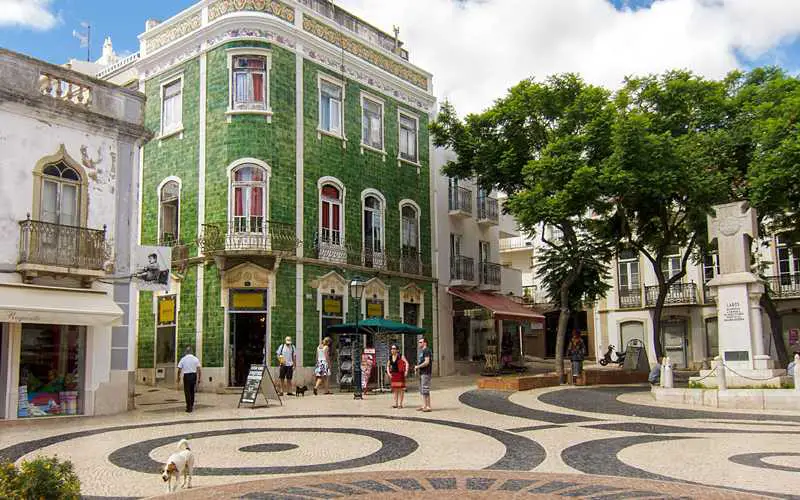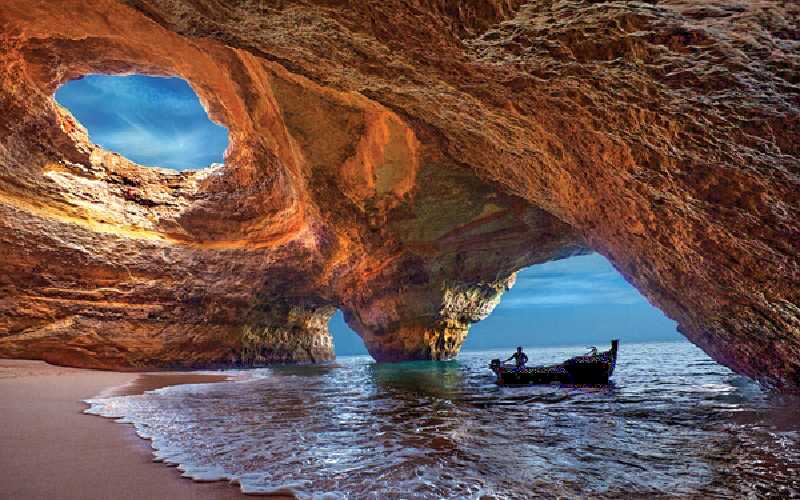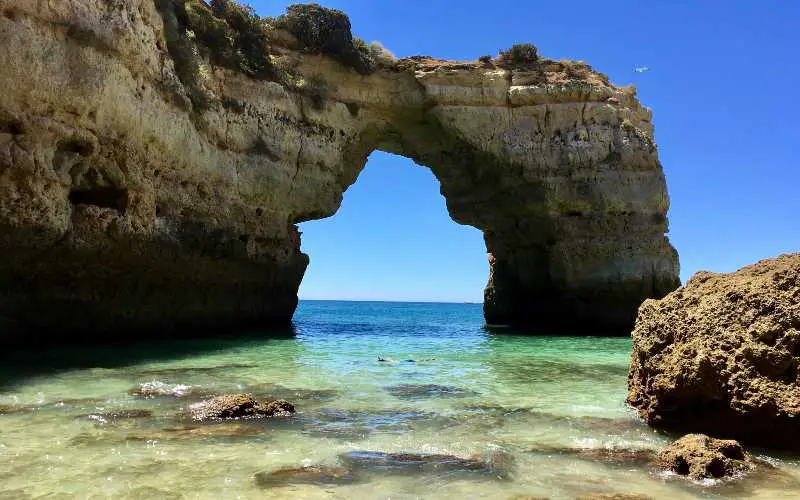The Algarve in the South of Portugal is a fantastic place for holiday makers due to the beautiful coastline and landscape. It is a popular holiday destination for Brits and Americans. Today we are exploring some of the best things to do in the Algarve including hiking, wine tasting and exploring Old Town Architecture.
Lagos Old Town

One of the best things to do in the Algarve is to take a walk through the old town of Lagos. Don’t miss the Santo Antonio Church, Mercado dos Escrevos and the Bandeira Fort.
The Old Town Lagos is surrounded by different types of fortifications, which represent an important aspect of its identity; they are symbolic elements that reflect the historical events and battles it faced over the years. It also has a lot of churches from different eras because Catholicism was one of the main religions at that time, particularly after King Dinis made it obligatory for everyone to be Christian and constructed several cathedrals across his kingdom. There are also some other significant buildings present on St Catherine Street (Rua de Santa Catarina), where most of the churches are, such as Isaac Aboab’s Synagogue.
The main reason why Old Town Lagos had to be fortified was so it could resist attacks from pirates and Muslim invaders. The first type of fortification that has been preserved until this day is the so-called “Filigree Wall.” It was built in the 16th century by King John III and served as a defense against cannons and fire ships which were used at that time. Even though today we are no longer worried about cannons, this type of wall still works perfectly well, hence its name (filigree) which means something delicate but very strong. Filigree walls usually have big machicolations (openings in the towers) which were designed as holes for archers and cannons.
Praia da Marinha Beach
Praia da Marinha Beach is a beach in the Algarve, Portugal. The beach is located within an Area of Outstanding Natural Beauty and has been awarded blue flag status for its cleanliness.
This sandy beach overlooks the Atlantic Ocean. There is a car park at nearby Praia dos Pescadores. The water temperature is comfortable all year round, making it popular with holiday makers and locals alike. Lifeguards operate daily during the summer months (April to September). Surfers visit this beach as well.
Benagil Cave

This coastal cave is one of the most beautiful sites on this coast because it has intriguing stalactites and stalagmites formations that have formed over thousands of years, which form trapezoidal pillars in white, beige or pink colour tones.
With clear waters surrounding them these rocks offer a unique spectacle to those who are interested in nature or marine ecology. They are home to all kinds of fish, crustaceans and molluscs that feed on plankton.
In the interior of the cave there is a small pool with crystal-clear waters used for recreational diving and as an open air swimming pool. The air inside is fresh and cool even during hot summer days.
The entrance to the cave has been adapted for use by visitors so it’s possible to walk along its length during low tide. Small boats can be taken through parts of the water course when sea levels are high enough. Boats can also be anchored in some points within this labyrinthine body of water which means that it’s possible to see different aspects from different angles.
Albufeira Strip
Started life as an innocent garden strip in the Algarve tourist resort of Albufeira, this watering hole has become a magnet for thousands of thirsty British holidaymakers.
It is now known all over Europe as ‘Albufuerian Strip’. The term was coined by journalists from German magazine Stern, who said it was “quite simply the best place to meet the most beautiful girls in Europe.”
Every night, thousands of holidaymakers head for what has been dubbed ‘The Strip’ by locals. It stretches from a bar called The Popeye down to Poseidon Beach all along the main promenade. Most are in their late teens and early twenties, many blond, and mostly from different parts of the UK.
The strip is open most nights, and even in the early hours there are still dozens of bikini-clad girls chatting to male holidaymakers. The area is under constant police surveillance, but it remains a popular destination for young British tourists.
7 Hanging Valleys
The “7 Hanging Valleys” are found in the western Algarve – to the west of the Serra de Monchique. They constitute one of Portugal’s most beautiful landscapes. Local folklore has it that they were formed by seven Moorish women who fled from a nearby battle and hid their faces with their veils to avoid capture.
Mendigo Pass is at the centre of the mountains running into each other. Its name derives from mendigo, or beggar since this was once an area frequented by gypsies and vagabonds. Legend tells that Mendigo had worked hard all his life only to marry a rich widow who left him a fortune. He went to the cathedral in Silves and promised to build a chapel in return for riches, but she died before he could fulfil his promise. Mendigo was so distraught that he hanged himself from an oak tree (which until 1957 could be seen just outside the town of Monchique).
The seven “vales” are named: Barranco do Lobo (Lobo ravine), Val Vicioso, Vale da Fenda (Fenda’s Valley), Val das Furnas (Furna’s valley), Vale de Marmeleiro, Vale de Carvalho and Vale do Vau (Vau’s Valley.) A 8 km trail starts at the Capela de Nossa Senhora da Conceição in Monchique and takes around 3 hours to complete. It leads through the towering cliffs of rock, forests, waterfalls and ravines.
This UNESCO World Heritage site is truly a spectacular place to visit and can be easily reached from the Algarve town of Portimão. From here you will need to take a taxi or drive yourself as far as Silves (around 40 km) before getting onto the main EN125 road which winds its way into Monchique and into these breathtaking valleys. The roads are incredibly narrow so caution should be taken at all times when driving but especially descending into this area known for its huge number of hairpin bends. Wedged between large rock faces and mountains, the “Seven Hanging Valleys” really are a sight to behold.
Tavira Island
It has several beautiful beaches, warm weather and good food. Also the people who work on the island and residents of this place are very nice, kind and helpful. And also it is possible to learn more about some cultural traditions of Portugal here (for example sardine festival). Before I went there I didn’t really know what to expect but it was great experience. There were not many tourists in this place which was one of my favourite parts but at the same time due to it being off season I had some difficulties with finding a suitable accommodation – as well as during check-out…
Ria Formosa
In the South of the Algarve, specifically in the municipalities of Alcoutim and Castro Marim, is one of the most important areas of natural heritage on Europe. This is inside an area called Ria Formosa Natural Park (Unidade de Conservação da Natureza).
The protected area extends over 321 km² and includes large coastal lagoons, sand dunes, salt marshes and tall cliffs. The whole region is a fascinating mix of diverse habitats that are home to rare species such as the pink flamingo or black stork.
Wine Tasting in Silves
Wine tasting and the history of wine production in Silves are a perfect combination to make your stay at this mystical town more enjoyable.
If you like wine, visit the Wine Museum and take part in one of their free wine tastings. The museum is located across from the main church but if you don’t fancy walking that far, there is a shuttle bus service from the tourist information office at the old town entrance.
The museum is housed in an eighteenth century building where rooms are still furnished as they were during the time of wine trade between Portugal and England. Each room has its own theme. The first one is dedicated to viticulture, where you can see how vines were planted and how wood was used to build wine barrels.
The rooms on the right are dedicated to port wines and brandies. There is a wide variety of old bottles, such as some from Dom Mateus Rousseau, who explored South America in the late nineteenth century. His name still lives on in one of the most famous brands of vintage port today.
Church of Sao Lorenco
This is an Itinerant church located in the civil parish of São João, municipality of Loures. The church was built to replace the prior chapel that had been constructed alongside a small body of water near the village.
The requested authorization for construction was signed by King Manuel I on January 1, 1514, but it would be a number of years later before the project was authorized: on October 1, 1552. Construction occurred over the course of eight years, during which time the master builder was Diogo de Arruda. It is possible that architect Francisco de Arruda also assisted in design or construction.
The building of the church was part of a larger project to drain the marshes and expand the area for agricultural production, by order of John III.
The church is situated alongside a small body of water, in an area that resembles marshland (due to its proximity to the Rio São Lourenço). The nave is essentially rectangular, with buttresses on its flanks and a central bell tower topped by a cork covered dome. The interior is divided into three horizontal floors: the first floor level marked by cornice and two semi-circular niches; second floor is defined by an arched ceiling supported by pilasters; while the third floor was one of several chapels and sacristies.
The main facade is composed of three concave gothic arches in ochre stone, with rose window located over the central door. The interior and exterior are decorated with various azulejos that are painted and glazed.
If you enjoyed this article you might also like to read about Algarve Itinerary and Things to do in the Algarve in Winter



3 thoughts on “Best things to do in the Algarve”